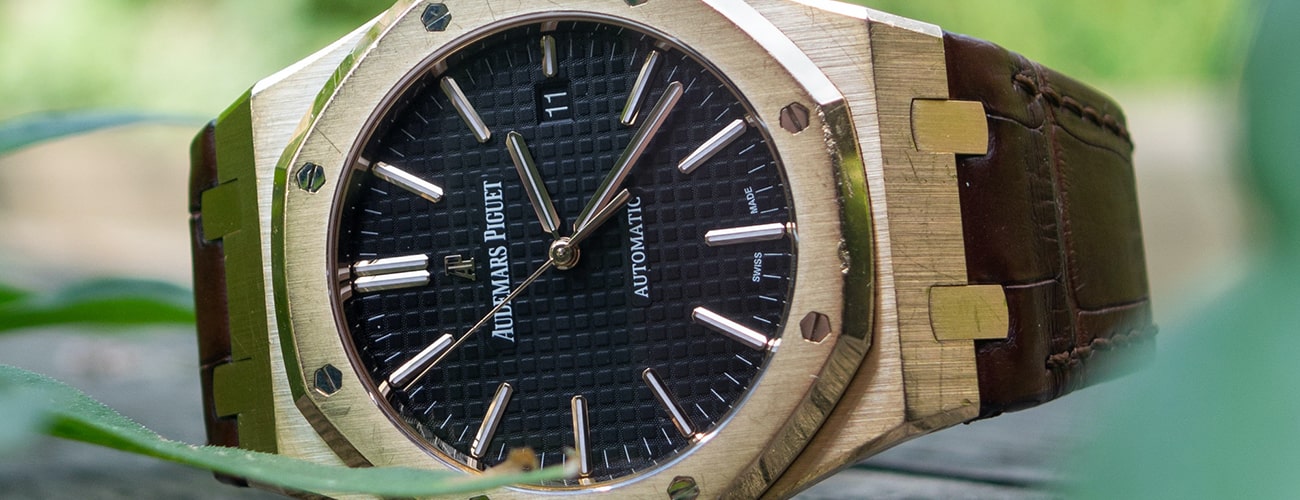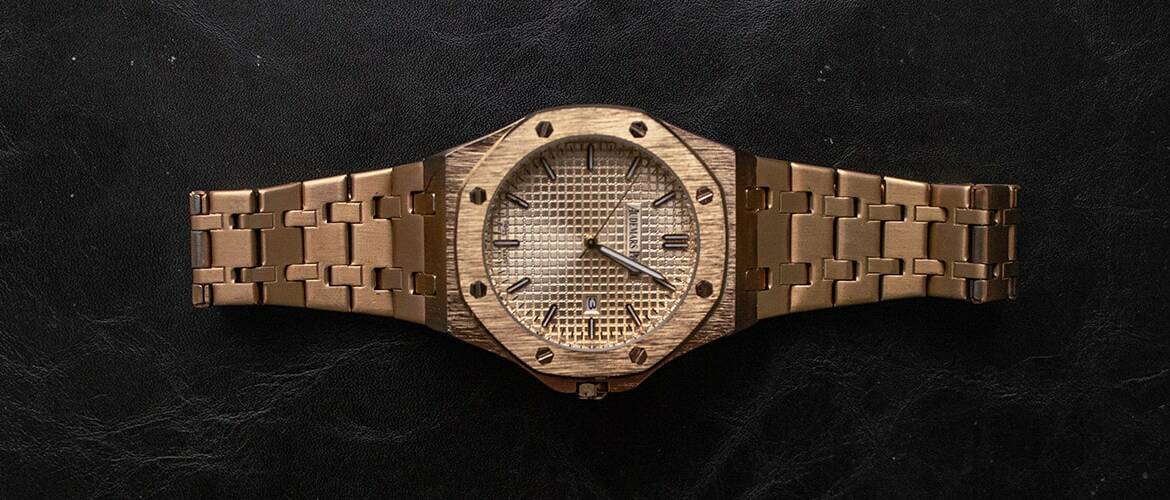AP Royal Oak Basics: History, Production & Specifications
In the world of horology, few timepieces manage to capture both history and innovation as gracefully as the Audemars Piguet Royal Oak. A synthesis of intricate craftsmanship and revolutionary design, the Royal Oak has become more than just a watch; it’s an emblem of luxury, engineering, and style.
Whether you’re a seasoned watch aficionado or just beginning to appreciate the art of timekeeping, this blog will delve deep into the roots of the Royal Oak, tracing its remarkable history, understanding the intricacies of its production, and shining a light on its specifications.
What’s The History Of The AP Royal Oak?
Early 1970s: In the early 1970s, the Swiss watch industry faced challenges from the rise of quartz watches, which threatened the dominance of mechanical timepieces. During this time, Audemars Piguet tasked Gérald Genta, a renowned Swiss watch designer, with creating a revolutionary luxury sports watch that would save the company from the quartz crisis.
Genta took inspiration from a traditional diving helmet, specifically the octagonal shape and visible screws that held the helmet together. He incorporated these design elements into the Royal Oak, creating a distinctive and avant-garde watch. The name “Royal Oak” was derived from a series of eight British naval ships with the same name, which were named after the oak tree within which King Charles II of England hid to escape his enemies.
1972: When the Royal Oak was introduced at the Baselworld watch fair in 1972, it was met with mixed reactions. Its bold and unconventional design, featuring an integrated bracelet and a large 39mm stainless steel case, challenged traditional luxury watch aesthetics. Moreover, its price was significantly higher than that of most steel watches at the time. Despite the initial scepticism, the Royal Oak gradually gained popularity, eventually becoming one of the most sought-after luxury watches in the world.
💡 Read more: How Much Are Royal Oaks?
Modern day: Today, the Audemars Piguet Royal Oak remains a symbol of horological excellence and a testament to the audacious vision of its creators. It continues to be produced in various forms, showcasing the brand’s commitment to craftsmanship, innovation, and timeless design.
What Type Of Watch Is Audemars Piguet Royal Oak?
The Audemars Piguet Royal Oak is primarily classified as a luxury sports watch. It combines elements of both a dress watch and a sports watch, making it a versatile timepiece that can be worn in a variety of settings.
While sports watches are typically associated with ruggedness and functionality, the Royal Oak distinguishes itself with its elegant and sophisticated design. It features a distinctive octagonal-shaped case with visible screws, an integrated bracelet, and a combination of polished and brushed finishes. These design elements, along with the meticulous craftsmanship, elevate the Royal Oak to a high-end luxury timepiece.
The Royal Oak’s sporty nature is further emphasised by its water resistance, which is a standard feature across the collection. The original Royal Oak was water-resistant to 50 metres, and subsequent models have increased this capability. The Royal Oak Offshore line, introduced in 1993, takes the sporty aesthetic to the next level with larger case sizes and bolder designs, targeting those with an active lifestyle.
Despite its sporty origins, the Royal Oak’s refined design allows it to seamlessly transition from casual to formal occasions. It has gained recognition as a status symbol and is often worn as a dress watch by enthusiasts who appreciate its luxury appeal and horological excellence.

What’s So Special About The Royal Oak?
The Audemars Piguet Royal Oak stands out for several reasons, making it a truly special and iconic timepiece. These factors, combined with the enduring popularity and desirability of the Royal Oak among collectors and enthusiasts, contribute to its status as one of the most special and iconic watches in the world.
- Revolutionary design: The Royal Oak’s design, created by renowned watch designer Gérald Genta, was groundbreaking at the time of its introduction in 1972. It introduced a bold and unconventional aesthetic to the world of luxury watches, challenging traditional norms. The octagonal shape of the case, inspired by a diving helmet, along with the visible screws and integrated bracelet, created a unique and instantly recognizable look.
- High-end materials and finishing: The Royal Oak is crafted with exceptional attention to detail, using high-quality materials. The case is often made of stainless steel, although Audemars Piguet also offers versions in precious metals like gold and platinum. The finishing techniques applied to the watch, including polished and brushed surfaces, enhance its visual appeal and reflect the brand’s commitment to craftsmanship.
- Superb craftsmanship: Each Royal Oak is meticulously assembled and finished by skilled watchmakers. The complex construction of the case, with its multiple facets and polished bevels, requires exceptional precision and expertise. The attention to detail extends to the dial, hands, and movement, resulting in a timepiece that exemplifies horological excellence.
- Iconic bracelet design: The Royal Oak’s integrated bracelet is an integral part of its design and contributes to its distinctive character. The bracelet alternating polished and brushed links, combined with its seamless integration into the case, create a seamless and cohesive aesthetic.
- Versatility: Despite its sporty origins, the Royal Oak is a versatile watch that can be worn in various settings. Its refined design allows it to transition effortlessly from casual to formal occasions. Whether paired with a suit or worn with a casual outfit, the Royal Oak exudes an air of luxury and sophistication.
- Historical significance: The Royal Oak played a crucial role in redefining the luxury watch market in the 1970s. It saved Audemars Piguet from the quartz crisis by demonstrating that there was still demand for mechanical watches, even in a changing industry. Its success paved the way for other luxury sports watches and solidified its place in horological history.
What Are The Key Specifications Of An Audemars Piguet Royal Oak?
- Case: The Royal Oak typically features a case size ranging from 33mm to 41mm in diameter. The case is often made of stainless steel, but Audemars Piguet also offers versions in precious metals like gold and platinum. The case is known for its distinct octagonal shape and integrated bracelet design.
- Bracelet: The Royal Oak is renowned for its integrated bracelet, which seamlessly blends into the case. The bracelet consists of a combination of polished and brushed links and is often crafted from the same material as the case, whether stainless steel or precious metals.
- Dial: Royal Oak dials come in a variety of colours, textures, and finishes, including the signature “Grande Tapisserie” pattern. The dials feature a mix of applied hour markers, typically in the form of batons or Arabic numerals, with luminescent coating for visibility in low-light conditions. Some models may also include additional functions like chronograph subdials or date displays.
- Movement: Audemars Piguet equips the Royal Oak with high-quality mechanical movements, often with automatic winding. The specific movement can vary depending on the model and edition, ranging from simple three-hand movements to complex complications like chronographs, perpetual calendars, or tourbillons. The movements are known for their precision and finishing, often visible through the exhibition case back.
- Water resistance: The Royal Oak is designed as a sports watch and typically offers water resistance ratings ranging from 50 metres to 100 metres (5 ATM to 10 ATM), depending on the specific model. This allows for some degree of water resistance, making it suitable for daily wear and occasional water-related activities.
💡 You might like this guide: How To Adjust & Set The Time On Your AP Royal Oak
Who Wears Audemars Piguet Royal Oak Watches?
Celebrities from various fields, such as actors, musicians, athletes, and entrepreneurs, have been spotted wearing Audemars Piguet Royal Oak watches. Some notable examples include LeBron James, Jay-Z, Arnold Schwarzenegger, Drake, John Mayer, and Serena Williams. These high-profile individuals often contribute to the popularity and desirability of the Royal Oak collection.
In addition to celebrities, Royal Oak watches are favoured by watch enthusiasts who appreciate the brand’s heritage, craftsmanship, and attention to detail. These individuals may be avid collectors or simply appreciate the iconic design and horological significance of the Royal Oak.

How Can You Spot A Fake AP Royal Oak?
Spotting a fake Audemars Piguet Royal Oak requires careful examination and attention to detail.
- Authorised dealer: Purchase from an authorised Audemars Piguet dealer or a reputable source to minimise the risk of buying a fake watch.
- Overall wuality and finishing: Authentic Royal Oaks exhibit exceptional craftsmanship and attention to detail. Examine the watch for any visible flaws, such as rough edges, uneven finishing, or misaligned components. The quality of the materials, including the case, bracelet, and dial, should be of high standard.
- Serial and model numbers: Check the serial and model numbers engraved between the lugs on the side of the case. Genuine AP Royal Oaks have precisely engraved and evenly spaced numbers. Counterfeit watches may have shallow or poorly engraved numbers.
- Logo and branding: Inspect the Audemars Piguet logo, text, and other brand markings. Genuine watches have crisp, clean engravings, with consistent fonts and spacing. Counterfeit watches often have inaccurately reproduced or poorly executed logos and engravings.
- Dial details: Pay close attention to the dial. Look for any irregularities in the logo, hour markers, or hands. The hour markers on authentic Royal Oaks should be precisely applied and well-aligned. The quality of printing and finishing should be of high standard.
- Movement: The movement inside the watch can be a good indicator of authenticity. Audemars Piguet uses high-quality Swiss movements. If possible, open the case back to inspect the movement. If you are unsure, consult with a professional watchmaker or take the watch to an authorised dealer for verification.
- Hologram and laser etching: Genuine Royal Oaks have a hologram on the case back and a small, laser-etched AP logo on the sapphire crystal. Counterfeit watches may have poorly executed or missing holograms and laser etchings.
- Weight and sound: Authentic Royal Oaks are well-constructed and have a solid feel. They should have a substantial weight and a smooth, precise movement of the hands. Be wary of watches that feel excessively light or have a loud ticking sound.

